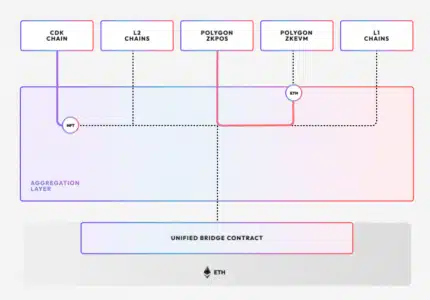Tired of the hassle of bridging assets between different blockchains? Imagine a crypto world where navigating various networks feels as smooth as surfing the internet. That’s the future Polygon Labs is building with its groundbreaking new protocol, AggLayer, slated to launch next month. Get ready to say goodbye to cumbersome bridging and hello to a truly interconnected blockchain experience!
What is Polygon’s AggLayer and Why Should You Care?
Polygon Labs, the team behind the popular Ethereum scaling solutions, is tackling a major challenge in the crypto space: the fragmented blockchain landscape. Currently, blockchains operate largely in silos, requiring users to jump through hoops – often involving complex and costly bridges – to interact with different networks. AggLayer aims to dismantle these walls, creating a unified web of blockchains that operate as if they were a single, cohesive chain.
- Imagine this: You hold DAI on Ethereum Layer 2 (L2) X1 and want to snag that cool NFT on Polygon zkEVM. With today’s typical setup, you’d have to bridge your DAI over to Polygon zkEVM first. Sounds like extra steps, right?
- Enter AggLayer: Polygon Labs envisions a world where you can directly use your DAI on X1 to buy that NFT on Polygon zkEVM, without any bridging in between!
According to Polygon Labs, the user experience will be transformed, becoming as intuitive as using the internet. No more worrying about network boundaries or the complexities of cross-chain transfers. “From the end-user perspective, this will feel like using a single chain,” Polygon Labs stated in their blog post. Users can seamlessly interact with decentralized applications (dApps) across different chains without even realizing they are accessing separate networks.

The Vision: A Unified and Scalable Blockchain Network
Polygon Labs’ motivation behind AggLayer stems from a core belief: blockchains should function as a unified, highly scalable network, much like the internet itself. Currently, the blockchain ecosystem is characterized by:
- Silos: Blockchains operate in isolation, hindering interoperability.
- Poor User Experience: Bridging is cumbersome and often confusing for the average user.
- Scaling Limitations: Fragmented liquidity and network effects limit overall scalability.
AggLayer is designed to address these pain points head-on, paving the way for a more connected and user-friendly Web3 experience.
AggLayer: Bridging the Gap Between Monolithic and Modular Architectures
To understand AggLayer’s innovation, it’s helpful to briefly touch upon existing blockchain architectures:
- Monolithic Blockchains: Think of Bitcoin. These chains handle all functions – transactions, settlements, and data availability – on a single layer. They are secure and simple but can face scalability challenges.
- Modular Blockchains: Ethereum post-Merge is a prime example. These chains distribute functions across different layers (e.g., execution layers, data availability layers) to enhance efficiency and scalability. However, they can sometimes introduce complexity in interoperability.
AggLayer takes a different approach, leveraging the power of Zero-Knowledge (ZK) proofs to achieve aggregation. As Polygon Labs explains, “Aggregation synthesizes the benefits of both integrated (monolithic) and modular architectures using ZK technology.” This means AggLayer aims to provide the security and simplicity of monolithic chains with the scalability and flexibility of modular designs.
How Does AggLayer Work Its Magic?
AggLayer’s core mechanism involves aggregating ZK proofs from multiple blockchains. In simpler terms, ZK proofs allow one blockchain to verify transactions or states on another blockchain without needing to reveal the underlying transaction details. By aggregating these proofs, AggLayer can effectively “merge” the security and state of multiple chains, making them feel like one unified network.
This approach enables:
- Seamless Cross-Chain Transactions: Users can transact across different chains without bridging assets.
- Unified Liquidity: Liquidity across aggregated chains becomes accessible as if it were on a single chain.
- Enhanced User Experience: Complexity of navigating multiple chains is abstracted away, leading to a smoother user journey.
What’s Next for AggLayer?
Polygon Labs is rolling out AggLayer in stages:
- Version 1 (February Launch): The initial version will lay the foundation for aggregated blockchains, enabling the core functionality of unified state and cross-chain transactions within the AggLayer ecosystem.
- Version 2 (Later this Year): The second version will introduce support for asynchronous cross-chain transactions. This will further enhance the flexibility and capabilities of AggLayer, allowing for more complex and efficient cross-chain interactions.
With AggLayer, Polygon Labs is taking a bold step towards realizing the vision of a truly interconnected and user-friendly blockchain future. As the protocol launches and evolves, it has the potential to significantly reshape how we interact with the decentralized web, making the promise of a seamless, single-chain experience a reality.
See Also: Magic Eden Launches New Program To Reward Traders With NFT Token
Disclaimer: The information provided is not trading advice, Bitcoinworld.co.in holds no liability for any investments made based on the information provided on this page. We strongly recommend independent research and/or consultation with a qualified professional before making any investment decisions.


